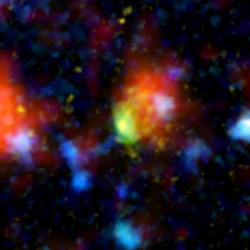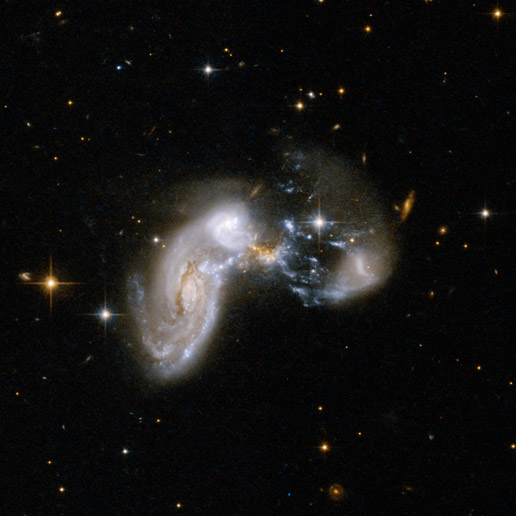This galaxy, Zw II 96 (about 500 million light-years away) resembles the Baby Boom galaxy which lies about 12.3 billion light-years away and appears in images as only a smudge.
A group of telescopes got together recently to check out a little hanky-panky going on in a galaxy in a very remote part of the universe. The Hubble and Spitzer Space Telescopes, Japan’s Subaru Telescope, the James Clerk Maxwell and the Keck Telescopes, all on Mauna Kea in Hawaii, and the Very Large Array in New Mexico pooled their various optical, infrared, submillimeter and radio capabilities to see why a distant galaxy appears to be conceiving stars at a tremendously fast rate. This galaxy, which has now been dubbed the “Baby Boom” galaxy, is giving birth to about 4,000 stars per year. In comparison, our own Milky Way galaxy turns out an average of just 10 stars per year. These telescopes weren’t just playing the part of a Peeping Tom; astronomers want to find out more about this incredibly fertile galaxy.
“This galaxy is undergoing a major baby boom, producing most of its stars all at once,” said Peter Capak of NASA’s Spitzer Science Center at the California Institute of Technology, Pasadena. “If our human population was produced in a similar boom, then almost all of the people alive today would be the same age.”
The discovery goes against the most common theory of galaxy formation, the Hierarchical Model. According to the theory galaxies slowly bulk up their stars over time, and not in one big burst as “Baby Boom” appears to be doing.
The Baby Boom galaxy, which belongs to a class of galaxies called starbursts, is the new record holder for the brightest starburst galaxy in the very distant universe, with brightness being a measure of its extreme star-formation rate. It was discovered and characterized using a suite of telescopes operating at different wavelengths. NASA’s Hubble Space Telescope and Japan’s Subaru Telescope, atop Mauna Kea in Hawaii, first spotted the galaxy in visible-light images, where it appeared as an inconspicuous smudge due to is great distance.

It wasn’t until Spitzer and the James Clerk Maxwell Telescope, also on Mauna Kea in Hawaii, observed the galaxy at infrared and submillimeter wavelengths, respectively, that the galaxy stood out as the brightest of the bunch. This is because it has a huge number of youthful stars. When stars are born, they shine with a lot of ultraviolet light and produce a lot of dust. The dust absorbs the ultraviolet light but, like a car sitting in the sun, it warms up and re-emits light at infrared and submillimeter wavelengths, making the galaxy unusually bright to Spitzer and the James Clerk Maxwell Telescope.
To learn more about this galaxy’s unique youthful glow, Capak and his team followed up with a number of telescopes. They used optical measurements from Keck to determine the exact distance to the galaxy — a whopping12.3 billion light-years. That’s looking back to a time when the universe was 1.3 billion years old (the universe is approximately 13.7 billion years old today).
The astronomers made measurements at radio wavelengths with the National Science Foundation’s Very Large Array in New Mexico. Together with Spitzer and James Clerk Maxwell data, these observations allowed the astronomers to calculate a star-forming rate of about 1,000 to 4,000 stars per year. At that rate, the galaxy needs only 50 million years, not very long on cosmic timescales, to grow into a galaxy equivalent to the most massive ones we see today.
“Before now, we had only seen galaxies form stars like this in the teenaged universe, but this galaxy is forming when the universe was only a child,” said Capak. “The question now is whether the majority of the very most massive galaxies form very early in the universe like the Baby Boom galaxy, or whether this is an exceptional case. Answering this question will help us determine to what degree the Hierarchical Model of galaxy formation still holds true.”
“The incredible star-formation activity we have observed suggests that we may be witnessing, for the first time, the formation of one of the most massive elliptical galaxies in the universe,” said co-author Nick Scoville of Caltech.
Original News Source: JPL


Naughty little galaxies .. It never ceases to amaze me that the more we think we know, the more we realise we don’t. Great piece, thanks.
This looks to me like a merger of 2 (or more?) galaxies. Would that not give an explanation for the starburst intensity?
I resent you calling it Babyboomer. Who brought you all this astronomy!!!!
It reminds us to think about how different things were when the known universe was very young. Stars forming with different composition, lack or nonexistance of many elements etc. How dynamic and large different voids would be; and how they would interact with areas with a great deal of matter.
How marvelous it would be to see this galaxy the way it truly is ‘today’.
The first sentence ends “…in a very remote universe.” surely they mean remote galaxy!
It actually reads ” …in a galaxy in a very remote PART of the universe. “
Just for those who may wish to search for further information on the galaxy pictured to illustrate this article, its’ proper designation is II Zw 96. Not to worry Nancy, both the JPL & Spitzer releases made the exact same error multiple times. I’m interested in interacting galaxies the designation of this object immediately caught my eye. But, thanks for a great story on an important aspect of the state of the universe at an early age.
II Zw 96 looks like three galaxies, left to rigt, A, B, and C. B has just passed through C, causing star formation, and is now side swiping A which has grown streamers toward B.
My eyes must be playing tricks on me. It looks like there’s a vertical line of optical distortion there. Maybe some gravitational lensing from a super dense linear structure of some kind? =)
ilove denise wow wowhhh
let me go here with denise:]